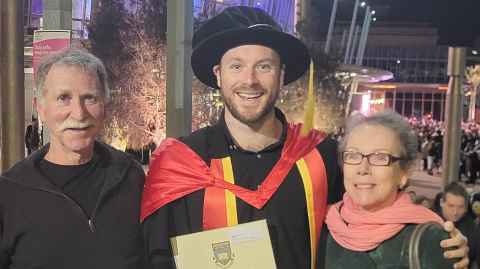Coupling models and energy conservation fundamental to realistic digital humans
5 October 2022
This Auckland Bioengineering Institute graduate switched from work on electric-car efficiency to modelling the body for human health.

From a young age, Dr Finbar Argus had an ambition to gain entry to the US college system on a tennis scholarship. Love for the game fell away but an unexpected curve ball led the young man to continue his studies in Aotearoa and reap experience at some of America’s most exclusive research laboratories.
Finbar’s honours project for his Bachelor of Mechanical Engineering degree explored mechanical lung ventilation to find a way to hone in on the optimum pressure to ventilate patients.
“I was sitting exams to do my postgraduate studies in America when Distinguished Professor Geoff Chase, my honours supervisor at the University of Canterbury, recommended I consider a position at the Auckland Bioengineering Institute (ABI) with Professor Peter Hunter instead.
“It seemed ideal. It had collaborations with MIT (Massachusetts Institute of Technology) in the US. I would still get the experience of going over to America and it was too good to turn down.”
Finbar set out on a PhD to explore computational methods to improve the performance of electric vehicles supervised by Professor Peter Hunter, Dr Chris Bradley and Dr Soroush Safaei.
While researching, he spent almost the better part of 2019 between NASA Ames Research Centre in California and Professor Ian Hunter’s Bioinstrumentation Lab at MIT in Boston.
Still, it has been the homegrown experience of working closely with other researchers at ABI and their application of engineering sciences and technical innovation to medicine and human physiology that altered Finbar’s trajectory.
We know what is happening in the vehicle because we have created the vehicle – whereas with the human body, so much of it is unknown.
“During my undergraduate years I really liked aerodynamics and vehicle dynamics and that is what I wanted to continue with. Then it completely changed.”
In his doctoral studies Finbar shifted his focus to modelling large coupled systems and multi-organ systems and on using energy conserving methods to couple multiple physiological systems.
“The more I began working with people involved in physiology, through osmosis, I started picking up some of the physiology knowledge. I grew to love the physiology modelling side. Now, I try to apply my computational modelling knowledge to physiology.”
“I looked at ways to couple systems together to conserve energy. That is important if we have a virtual model of a person or a circulatory system for example. Especially if we need to run the model for a long duration without leaking energy or mass. Energy conservation is very important for these coupled systems – especially when we look to the future to having digital twins or mathematical models of human physiology that can be used in the clinic, at the bedside.”
Finbar also worked on research around the autonomic nervous system creating a model on how our brain controls our circulatory system, how it controls pressure and blood flow to the brain “coupling together models of vessels and organs and being able to control that full system realistically is essential for developing realistic full-body physiological models.”
Now, as a postdoctoral research fellow, Finbar is conducting research with the Virtual Brain Group and the Cardiac Mechanics Research Group at the University of Auckland. He is first recipient of the Andrew Bagnall Fellowship which funds his research into autonomic nervous system control and provides yet another opportunity to train at a top-ranking international university. He is pretty happy with the way the ball has bounced with his academic career.
“What keeps me going is learning – and there is just so much to learn. On the aerodynamics side, a lot of what there is to learn is purely the modelling and the maths. I like learning the modelling and the maths as well as all this unknown physiology that is happening – and trying to discover exactly what is going on.
“We know what is happening in the vehicle because we have created the vehicle – whereas with the human body, so much of it is unknown.”
He is continuing this work in his postdoctoral research by creating coupled models of the cardiac, vascular, and respiratory systems, with the aim of creating a physiologically accurate combined system that can be used for clinical applications. This work is in conjunction with the 12 Labours project at the ABI, a project commissioned by MBIE to give the ABI a platform through which it could establish and enhance its global leadership in its field.
Media contact
Megan Fowlie | Media Adviser
M: +64 21 926 408
E: m.fowlie@auckland.ac.nz